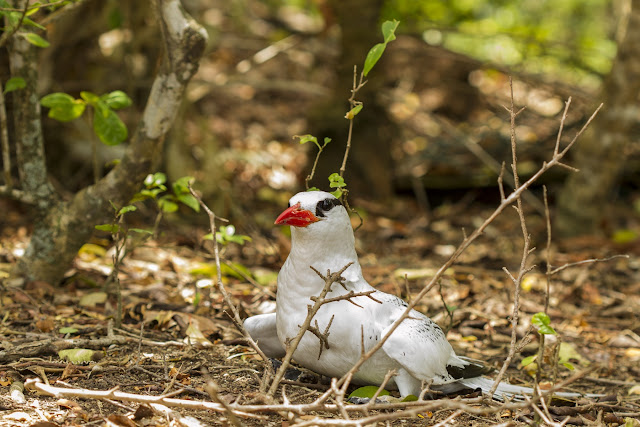Sea Birds on Little Tobago
Faraaz Abdool, environmentalist and
adventure birder, continues his exploration of the birds of Tobago. All photos
by Faraaz Abdool (This was first published in the Tobago Newsday, Thursday February 21, 2018)
Little
Tobago is visible from the coast as one begins to near Speyside, driving from
the south. With powerful binoculars, one may just be able to discern avian
shapes that are not found anywhere else within Tobago or Trinidad. As the
island is approached by boat, the distinctive, raking calls of Red-billed
Tropicbirds fill the air, especially during the first half of the year when
these graceful, angelic seabirds raise their young on lazily constructed nests
on the ground. A short hike to the top of the island and you arrive at convenient
and comfortable viewing platforms. At times, no optical aids are necessary as
the various species of seabird jostle for space no more than twenty feet away!
 |
| Magnificent frigatebirds over Little Tobago, on the lookout for an easy meal! |
These
islands are among the most accessible places in the world to view Red-billed
Tropicbirds, which typically nest on remote offshore islands. Each day, they
fly out to sea where they grab squid and fish – flying fish is a favourite –
and deliver either solid or semi-digested food, depending on the age of the
chick. Both parents repeat the process innumerable times until the chick has
fledged, when it will be encouraged to leave the nest and catch its own food.
Each fishing trip the parent makes is a dance through the gauntlet of greedy “Man
o’ Wars”.
Unlike
the Tropicbirds, Magnificent Frigatebirds do not have waterproof feathers; but they
too thrive on fish. To eat, these huge seabirds have perfected the art of
stealing. Once a returning Red-billed Tropicbird is sighted, the Frigatebirds
attack, dive-bombing the smaller bird, sometimes even pulling on its long
tail-streamers to get it to release its catch. The only way to escape
harassment would be to regurgitate whatever fish it is returning to the nest
with.
 |
| Brown booby from the observation deck on Little Tobago |
Other seabirds
also have to dodge the Magnificent Frigatebirds. Brown Boobies are relatively
common around beaches all over Tobago, and are a familiar sight for many
Tobagonians. The slightly less common Red-footed Booby nests on Little Tobago
and the islands of St Giles. Its red feet are a field mark for conclusive
identification, even though this bird comes in a few disguises – called “colour
morphs.” The brown morph is wholly brown, except for the very tip of its tail,
which is frosted white. The white morph is mostly white, with black flight
feathers. There is an intermediate morph as well, that is brown with a white
tail. All colour morphs have unmistakable red feet.
 |
| Brown morph red-footed booby |
White morph red-footed booby keeps an eye on its nest
|
Apart
from the species discussed here, sometimes a true wanderer visits our islands.
There have been records in the recent past of the smaller White-tailed
Tropicbird nesting among its Red-billed cousins. Also, just last year, there
were a few Masked Boobies spotted – causing much excitement among the local
birdwatching community. For special ecosystems such as these offshore islands,
it is imperative to consistently monitor the birdlife as a valuable
contribution to the worldwide knowledge base. Seabirds are generally difficult
to study, given their habits of being in the open, uncharted ocean for most of
the year. The only chance we have to study, or view, these birds would be when
they choose to breed. This underscores the need to ensure that they have stable
and secure nurseries to which they might return year after year.
Another
silent colonizer of these islands in recent times is no seabird. Scaly-naped
Pigeons are relatives of the feral pigeons we see in urban areas, and they are
relatively common in the greater Caribbean region. Some years ago, a few
intrepid individuals discovered the islands of St Giles and Little Tobago, and
their population is expanding. Just a couple years ago, I saw a Scaly-naped
Pigeon in Charlotteville, one of the first records of this bird on mainland
Tobago.
 |
| Scaly-naped pigeons - this one was photographed in Barbados - have arrived on Little Tobago. |
As with
any patch of forest, the more you look, the more you see. Many birds are heard
long before they are seen. Bananaquits never stop chattering, and they usually
provide accompaniment on the walk through Little Tobago. Listen for the “whoop”
of the Trinidad Motmot, and you’ll quickly be able to find the brilliantly
coloured King-of-the-woods, more than likely with its eyes already fixated on
the human presence. Another bird that seems to vocalize incessantly is the
Red-eyed Vireo; this bird currently holds the record for the most calls made in
a single day. The subspecies found on Little Tobago is called the “Chivi
Vireo”, and may soon be recognized as a separate species altogether!
 |
| The resident subspecies of Red-eyed Vireo on Tobago, Vireo olivaceus tobagensis is endemic to Tobago |
White-tailed Nightjar
roosting on Little Tobago.
|
Some
birds do not bless us with song as others do. Nor are they coloured with
various shades of yellow, green or blue. So it’s quite understandable that you
might overlook the presence of a White-tailed Nightjar while on Little Tobago.
These cryptic birds blend in seamlessly with their surroundings; nocturnal
birds, they sleep during the day and must be able to remain unseen even while
asleep. Once darkness falls it’s another story.
(See more birds of Tobago and Trinidad on Faraaz Abdool's site faraazabdool.com)





